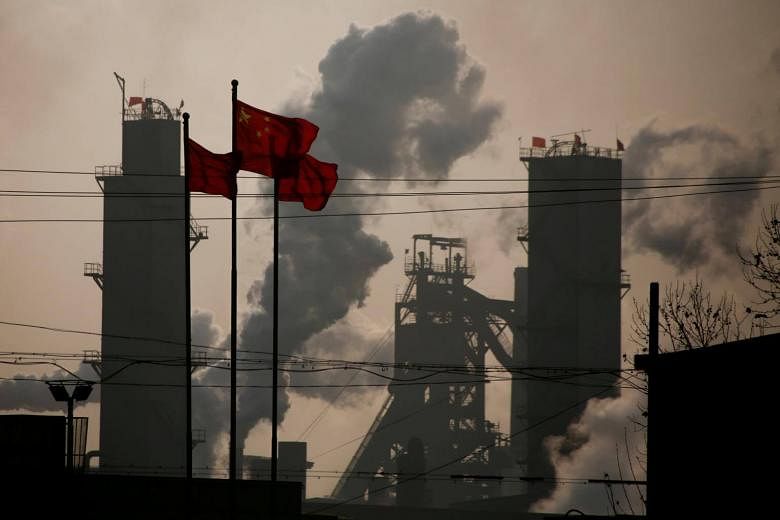BEIJING (BLOOMBERG) - President Xi Jinping's big push to curb pollution and excess capacity in steel and other industries is also consolidating his government's control over them.
Just last year, the state's share of steel capacity increased to 67 per cent from 60 per cent while aluminum smelting saw about an equal increase, J Capital Research Ltd. estimates.
In coal, which began consolidating years earlier, the government now controls 80 per cent of capacity compared with about 45 per cent in 2010, according to the Hong Kong-based firm.
Xi's campaign has boosted corporate profits, ended years of deflation, and stabilised debt growth to help underpin the first full-year economic acceleration last year since 2010. But his aim for a "bigger, better and stronger" state role also means those bloated companies risk stifling private ones, as the Communist Party strengthens its grip on the economy.
Call it "de facto nationalisation," says Jude Blanchette, China practice lead at Crumpton Group in Arlington, Virginia, and a former Conference Board researcher in Beijing.
"We're clearly seeing the re-strengthening of state-owned enterprises, oftentimes at the zero-sum expense of private players. Private folks are exiting the market either because they're pushed out or they can't survive."
State gains in heavy industry follow a broad SOE comeback since Xi took power in 2013. Their share of fixed-asset investment stopped falling in 2014 and rebounded over the next three years, says Andrew Batson, head of research at Gavekal Dragonomics.
The state is also extending control over the private sector away from heavy industry as it cracks down on debt. Once-acquisitive insurer Anbang Insurance Group Co. was seized by the government, and regulators have curtailed the activities of conglomerates including Dalian Wanda Group Co. and HNA Group Co.
Such consolidation may spur blowback from the US and other countries. President Donald Trump already brands China a strategic rival, slapping tariffs on its goods and criticising industrial policy for subsidising state enterprises in a push to dominate tech sectors.
"The idea, promoted during the Zhu Rongji era, that state enterprises should be independent, profit-seeking companies that just happen to be owned by the state has essentially been abandoned," said Batson, referring to the former premier.
"The government thinks that SOEs are there to serve its overall strategic goals."
While anti-pollution sweeps closed some private enterprises, state firms get a gentler touch. Jinan Steel, a unit of Shandong Iron and Steel Co. with about 20,000 employees, was shut in July. But many workers were moved to another unit.
Premier Li Keqiang then visited to say that while closures hurt, the nation would work to ensure employees get new jobs.
Total assets of central enterprises under the State-owned Assets Supervision and Administration Commission surged to 55 trillion yuan (US$8.7 trillion) last year from 10 trillion yuan in 2005 as return on assets fell to 2.6 per cent from as much as 7 per cent, says Nicholas Lardy, a senior fellow at the Peterson Institute for International Economics in Washington.
"There's a massive decline in the efficiency of these companies," said Lardy, whose 2014 book "Markets over Mao: The Rise of Private Business in China" highlights private sector contributions to growth.
"They're a huge drag on economic growth. The entire universe of state industrial companies is earning about 3 per cent. The returns are still pathetic."
China often says it can't be judged by the same standards as advanced economies. Huang Huiqun, a researcher at the Chinese Academy of Social Sciences, a government think tank in Beijing, says a dominant state sector is hard to avoid in the developing economy which requires large-scale infrastructure projects.
"State enterprises are better positioned to use and control resources," Huang says.
On the upside, air pollution improved in many cities last year as small companies fouling the skies were shuttered. State companies often survived because, unlike private companies, they had the money to meet environmental regulations.
The economic impact of a bloated state sector also may be contained if services and consumption continue to boost output.
"The state is definitely becoming dominant in old-line industries," says Andrew Collier, an independent analyst in Hong Kong and former president of Bank of China International USA.
"But over time, the success of private firms in more advanced manufacturing and new technologies will supersede the old-line state enterprises."
Long Term Risk Consolidation continues. China's cement association has said it will shutter 540 grinding companies this year and allocate 60 per cent of capacity to top producers by 2020, in line with a State Council order.
The risk is short-term gains mean longer-term pain. The producer inflation boost already is easing, suggesting profits driven up by pricing power amid capacity cuts may soon weaken.
Eighty per cent of steel capacity eliminated in 2016 and 2017 was at private steel mills while 75 per cent of additions were at state enterprises, says J Capital managing partner Tim Murray in Sydney. Eighty-eight per cent of aluminum capacity eliminated last year was in private companies and 75 per cent of additions in state enterprises, he says.
"They're squeezing out private players and pouring more money into state players," he said.

